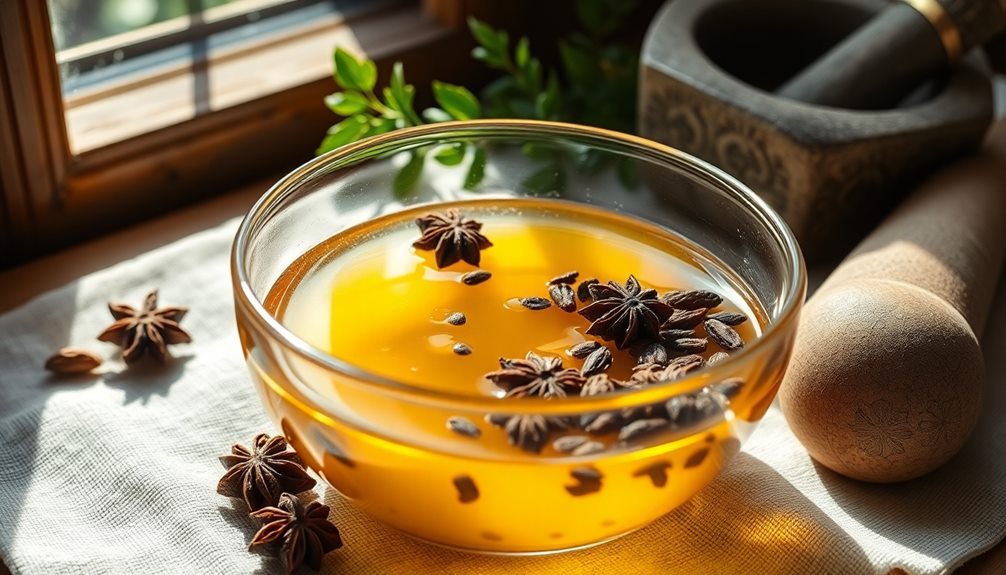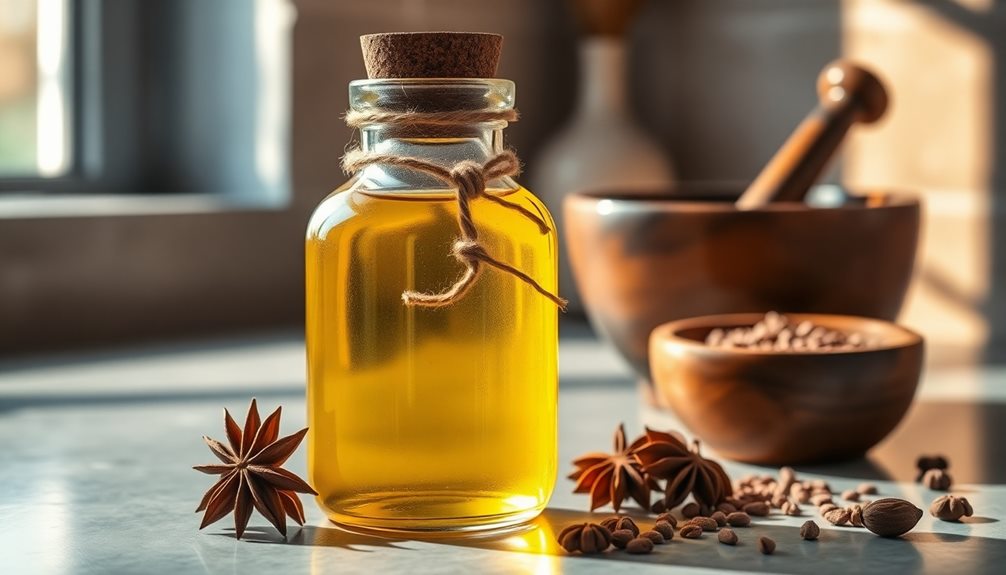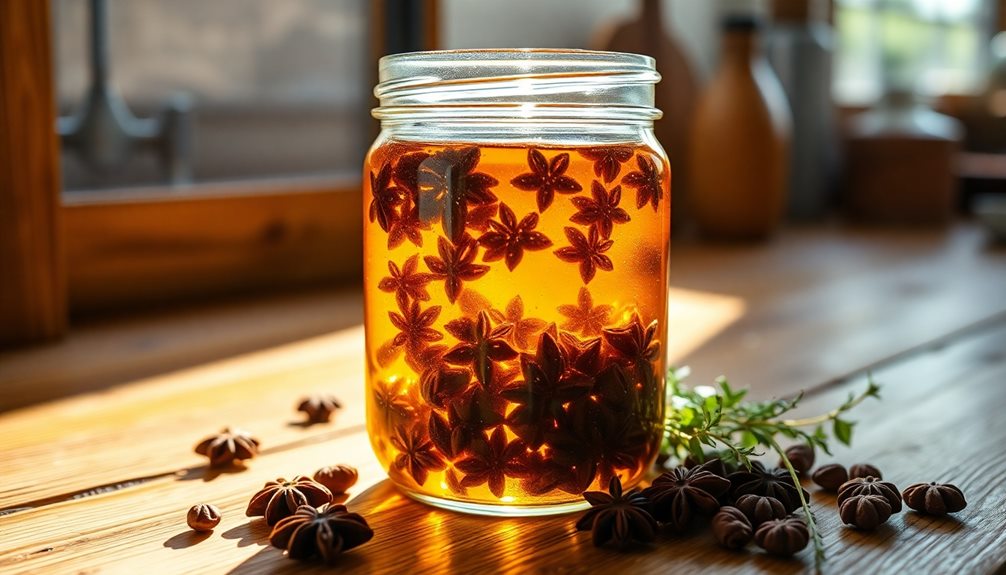Anise oil is a fragrant powerhouse packed with digestive and antibacterial benefits. It can soothe discomfort, reduce bloating, and alleviate respiratory issues. To make your own, grind dried anise seeds and infuse them in a carrier oil, like almond or jojoba, for two to four weeks in a warm spot. Gently shake the mixture and strain it using cheesecloth for a pure extract. Store it in a dark glass container to maintain its potency. This versatile oil not only enhances culinary dishes but also uplifts your mood, offering a holistic touch to your wellness routine. Explore its rich benefits further!
Summary
- Anise oil is beneficial for digestive health, relieving bloating and indigestion while promoting overall wellness.
- It possesses strong antibacterial and antifungal properties, serving as a natural antiseptic for minor wounds.
- Historically, anise oil has been used for respiratory issues and is incorporated into various culinary dishes.
- To make your own anise oil, infuse dried anise seeds in a carrier oil for two to four weeks in sunlight.
- Store the infused oil in a cool, dark place, ensuring it's well-sealed to maintain its potency and aroma.
Antibacterial and Antifungal Properties
Anise oil boasts impressive antibacterial and antifungal properties, making it a significant addition to your natural health toolkit. These potent anise oil antimicrobial properties help combat various infections and support your body's defenses. Much like the benefits of clove bud oil, anise oil can enhance your overall well-being.
When you incorporate anise oil into your health routine, you're tapping into a wealth of benefits that can enhance your overall well-being. For instance, anise oil effectively targets harmful bacteria and fungi, reducing the risk of infections in wounds and skin conditions. You can use it as a natural antiseptic to clean minor cuts, promoting faster healing while preventing bacterial growth.
Additionally, the antifungal aspects of anise oil can help alleviate skin irritations caused by fungal infections, keeping your skin healthy and vibrant. Beyond topical applications, you might find that inhaling anise oil's aromatic compounds can also support respiratory health.
It acts as a decongestant and expectorant, making breathing easier when you're feeling under the weather. By embracing anise oil benefits, you not only elevate your self-care routine but also harness the power of nature to maintain your health and well-being.
Historical Medicinal Uses
Throughout history, the remarkable healing properties of anise oil have captivated civilizations, shaping its role in traditional medicine. Ancient cultures recognized anise oil's benefits, using it to promote digestive health and alleviate respiratory issues. The Egyptians incorporated it into their breads, while Romans added it to cakes, highlighting its medicinal and culinary significance.
Additionally, much like chamomile essential oil, anise oil has been appreciated for its ability to soothe and relax those who consume it, enhancing its therapeutic profile.
Anise oil history reveals its use in various pharmaceuticals, particularly in cough syrups and throat medications. Its antiseptic qualities made it a go-to for cleaning wounds, while its narcotic and sedative effects provided relief during epileptic and hysteric episodes. Many cultures also valued anise oil for its pain-relieving properties, often using it to ease arthritis discomfort.
Beyond its physical benefits, anise oil uses also extended to enhancing breast milk production, serving as a natural insecticide, and even acting as an aphrodisiac.
With such a rich history, anise oil has been more than just a flavoring agent; it's been a cornerstone of holistic healing practices. As you explore its uses today, remember the profound legacy that anise oil carries from ancient medicinal traditions.
DIY Anise Oil Instructions
Making your own anise oil at home is a rewarding process that allows you to harness the numerous benefits of this fragrant herb. Anise oil, with its distinctive sweet and licorice-like aroma, has been prized for centuries not only for its culinary uses but also for its medicinal properties. Additionally, like cilantro essential oil, anise oil may offer various benefits, including potential antimicrobial effects.
Whether you're looking to use it in cooking, for therapeutic purposes, or just to enjoy its scent, creating anise oil is a straightforward endeavor.
To begin, it's important to choose high-quality dried anise seeds, which will guarantee that the flavor and benefits are potent. The process involves infusing these seeds in a carrier oil, allowing the natural oils to be extracted over time. This method not only preserves the essence of the anise but also creates a versatile oil that can be used in various applications.
Ingredients:
- Dried anise seeds
- Carrier oil (e.g., almond oil)
- Mortar and pestle
- Cheesecloth
- Glass container
To make anise oil, start by gently grinding the dried anise seeds in a mortar and pestle to release their essential oils. Next, transfer the ground seeds into a glass container and pour your chosen carrier oil over them, making sure that the seeds are fully submerged.
Seal the container tightly and place it in a sunny spot for a few weeks, allowing the heat to aid in the infusion process. After the infusion period, strain the mixture through cheesecloth to separate the oil from the seeds, then store your anise oil in a cool, dry place.
When making anise oil, it's important to remember that patience is key; the longer the seeds infuse in the oil, the more robust the flavor and benefits will be. Additionally, make sure that your glass container is airtight to preserve the quality of the oil.
Regularly check the oil during the infusion period for any signs of spoilage, and always use clean utensils to avoid contamination.
Infuse in Sunlight for Weeks
After sealing your glass container with the ground anise seeds and carrier oil, it's time to harness the sun's warmth for the infusion process. Just like the benefits of agarwood essential oil for relaxation and meditation, the gentle warmth of the sun will help extract the oils from the seeds, giving you a rich, aromatic anise oil.
Place your container in a sunny spot, where it can soak up those golden rays. This natural heat will help extract the oils from the seeds, giving you a rich, aromatic anise oil.
You'll want to let it infuse for about two to four weeks. During this time, gently shake the container every few days to encourage the blending of flavors. As the days pass, you'll notice the oil gradually darkening and taking on the distinctive scent of anise.
This is a key part of your anise oil recipe, making it a holistic and natural approach to oil extraction.
When it's ready, you'll strain the oil through cheesecloth to remove the seeds, leaving you with a beautifully infused anise oil. This process not only enhances the oil's flavor and benefits but also connects you to the essence of anise.
Now you know how to make anise oil with just a little patience and the power of sunlight!
Step 1. Grind Seeds With Mortar

To begin crafting your anise oil, you'll need to take a handful of dried anise seeds and prepare them for infusion. Start by placing the seeds in a mortar. Using the pestle, gently grind the seeds in a circular motion. This method not only releases the essential oils but also enhances the flavor profile of your homemade anise oil.
The grinding process can be similar to extracting the musky, sweet aroma found in the allure of ambrette seed absolute, which is known for its calming properties. Aim for a coarse texture; you don't want to turn the seeds into a fine powder. The goal here is to break down the seed's outer shell, allowing the aromatic compounds to escape.
As you grind, take a moment to breathe in the warm, sweet aroma of the anise—this is a sensory experience that connects you to the essence of the oil you're about to create.
Once you've achieved the right consistency, you're ready to move on to the next step in your oil-making journey. The grinding process is essential as it maximizes the infusion of flavors and benefits from the anise seeds into your carrier oil. This foundational step guarantees that your homemade anise oil will be rich in flavor and therapeutic properties.
Step 2. Submerge Seeds in Oil

With your ground anise seeds ready, the next step involves submerging them in the carrier oil. Choose a high-quality oil, like almond or jojoba, to complement the rich anise oil composition. This method can be incredibly beneficial, as it allows the oil to absorb not only the flavor but also the calming properties similar to those found in the calming effects of Balsam oil.
Pour the ground seeds into a clean glass container, guaranteeing there's enough space for the oil to mix well. Carefully pour the carrier oil over the seeds until they're completely submerged. This process is vital for anise oil inf, as it allows the oil to extract the beneficial compounds from the seeds.
Make sure the seeds are fully covered to prevent mold and guarantee an even infusion. Gently stir the mixture with a clean utensil, encouraging the release of the essential oils trapped in the seeds.
As the anise oil infuses, the carrier oil will begin to take on the distinct aroma and therapeutic properties of anise. Allow this mixture to sit in a warm, sunny spot for several weeks, shaking it gently every few days to enhance the infusion process. The warmth helps draw out the anethol and other beneficial components, enriching your homemade anise oil.
Step 3. Seal and Store Container

Once you've submerged the ground anise seeds in the carrier oil, the next step is to seal the container securely. This is essential for ensuring that your anise oil infuses properly and remains safe for use.
Cedarwood essential oil is also known for its calming properties, making it a great addition to your aromatherapy blends calming and grounding properties.
Here's what you need to keep in mind:
- Select a Tight-Lid Container: Use a glass jar with a tight-fitting lid to prevent air and contaminants from entering, which can spoil your oil.
- Store in a Cool, Dark Place: Light and heat can degrade the oil and its beneficial properties. Choose a cupboard or pantry that remains cool and dark.
- Label Your Container: Write the infusion date and any safety precautions on the jar. This helps you track how long it's been steeping and reminds you of the anise oil safety precautions you should follow, especially if you plan to use it for wound healing.
Step 4. Infuse for Two Weeks

How can you guarantee that your anise oil reaches its full potential? The key lies in the infusion process. After sealing your container, place it in a sunny spot where it can bask in warm light. This warmth helps extract the potent compounds from the anise seeds, enhancing the oil's flavor and therapeutic properties.
Additionally, like Amyris essential oil, which is known for its calming effects, anise oil can provide soothing benefits when infused properly discover the soothing benefits. For the next two weeks, resist the urge to shake or disturb the container too much; gentle exposure to sunlight is all you need.
During this period, the anise seed benefits will meld with the carrier oil, creating a rich blend perfect for various applications. You'll find that the anise oil culinary uses expand, making it a delightful addition to baked goods, marinades, and even herbal teas.
Remember to check on your infusion occasionally, appreciating the transformation happening within.
After two weeks, the oil will be ready for straining. Use cheesecloth to separate the oil from the seeds, capturing the essence of anise in its purest form.
With patience and care, you'll have a potent anise oil ready to enhance your cooking and wellness routines.
Step 5. Evaluate Oil Potency Before Use

After allowing your anise oil to infuse for two weeks, it's important to assess its potency before use. This step guarantees you're getting the most benefit from your oil while minimizing any potential anise oil side effects.
Here are three ways to evaluate your anise oil's potency:
- Smell: Take a whiff of your oil. A strong, sweet, licorice-like scent indicates a potent infusion. If it smells faint or weak, you may need to let it steep longer.
- Taste: If you're considering using it in culinary applications, place a drop on your tongue. The flavor should be robust and aromatic. If it's too mild, it's not fully potent.
- Consistency: Observe the oil's texture. A thicker oil typically signifies a richer extraction of the beneficial compounds. If it feels too thin, it might lack potency.
Final Thoughts
Creating your own anise oil can be a rewarding experience, merging both the art of cooking and the benefits of natural remedies. By engaging in this simple process, you're not just crafting a delightful oil; you're also tapping into the therapeutic benefits of anise that have been cherished for centuries.
Anise oil is renowned for its unique flavor and numerous health benefits, especially when it comes to digestive health. It's noteworthy that, similarly to caraway seed essential oil, anise also offers digestive support and can help relieve stress through its aromatic properties, making it a wonderful addition to your wellness routine digestive support benefits.
When you incorporate anise oil into your life, you're inviting a natural ally in relieving digestive discomfort. Its soothing properties can help alleviate symptoms of bloating and indigestion, making it a great addition to your wellness toolkit.
Plus, the aromatic scent of anise can uplift your mood, providing both mental and physical benefits.
As you explore the world of anise oil, remember to use it mindfully and experiment with different applications. Whether you're using it in your culinary creations or for its health benefits, you'll discover that anise oil is a versatile and valuable addition to your home.
Embrace the journey of making this oil, and enjoy the holistic benefits it brings to your life.
FAQ
Can Anise Oil Be Used in Aromatherapy?
Yes, you can use anise oil in aromatherapy. Its calming scent promotes relaxation, alleviates stress, and enhances focus. Just blend it with a carrier oil or diffuser, and enjoy its soothing benefits in your space.
What Precautions Should Be Taken When Using Anise Oil?
When using anise oil, you should avoid excess to prevent allergic reactions or nausea. Pregnant or nursing women need to exercise caution, and always consult a healthcare professional if you have specific health concerns.
How Does Anise Oil Interact With Other Medications?
Anise oil can interact with medications like anticoagulants, enhancing bleeding risks. It may also affect sedatives and antidepressants, increasing their effects. Always consult your healthcare provider before using anise oil alongside other treatments for safety.
Is Anise Oil Safe for Children?
Anise oil isn't recommended for children due to potential allergic reactions and side effects. Always consult a healthcare professional before using essential oils on kids, ensuring their safety and well-being in any treatment approach.
What Are the Signs of an Allergic Reaction to Anise Oil?
If you experience itching, swelling, hives, or difficulty breathing after using anise oil, it's likely an allergic reaction. You should stop using it immediately and consult a healthcare professional for further guidance.
